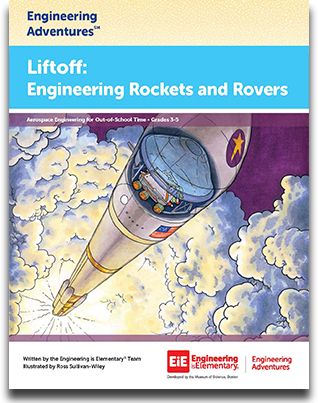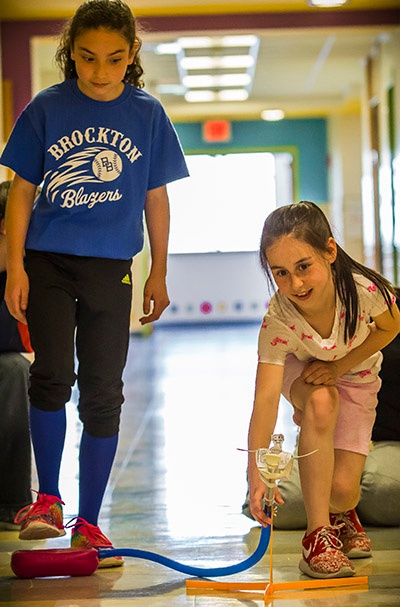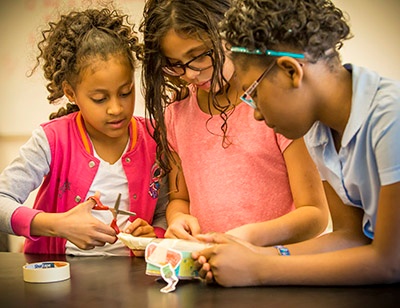 |
Teachers tell us that their students sometimes get so inspired by an engineering design challenge, they want to do MORE than the lessons call for. This is a good problem to have! Here’s a plan to extend STEM learning when you teach Liftoff: Engineering Rockets and Rovers, a popular unit from Engineering Adventures, the EiE curriculum for elementary out-of-school time programs.
Liftoff: What’s This Unit About?
 |
| This stomp rocket is cleared for takeoff! |
Liftoff introduces kids to aerospace engineering. They learn how rockets work and what they do, then design and build compressed-air-powered “stomp rockets” to explore how launch angle and payload weight affect a rocket’s flight distance.
The next step: learn about the “rovers” used to explore other worlds, then design a model rover, light enough to be carried by a rocket and capable of exploring the Moon, Mars, Pluto, or Titan (one of the moons of Saturn). These destinations differ in their surface composition and distance from Earth, and there are different science questions you can answer by exploring each world. So depending on the destination, kids will make different rover design choices!
Explore Even More
If your kids want to do MORE aerospace engineering (and we bet they will), consider this real-world connection: NASA has already completed lots of space explorations, other missions are underway right now, and even more missions are being planned.
 |
| Some rover tools are provided—but kids can invent their own! |
So invite your students to set their sights on one of the five missions listed below—or search the NASA site to find others. After they select a destination, kids can
- Conduct their own research to learn more about the planet (or moon) they’re aiming for
- Create their own research goals for a new space mission
- Choose the new rover tools needed for their mission and design a new rover
To make your student-driven space explorations even more exciting, consider making new “destination cards” and “rover tools” to supplement the ones already available—or let your kids create their own!
Five Intriguing Solar System Destinations
 |
| Imagination takes flight as kids design a space rover. |
- Mission to Mercury: Messenger Spacecraft Finds Water
- The Messenger spacecraft orbited Mercury from 2011 to 2015, carrying sensors that helped scientists learn about the planet’s surface composition and geological history. The sensors also revealed that polar deposits are mostly water ice!
- Mission to Europa: Mysteries Under the Ice?
- Europa, a moon of Jupiter, may hide an ocean of liquid water under its icy crust—and perhaps this ocean supports life! The spacecraft that will help researchers find out is still being designed, with plans for a launch in the year 2022.
- Mission to Jupiter: Juno Parts the Clouds
- The dense cloud cover on Jupiter conceals its surface. How did this planet form? What is it made of? Juno, a spacecraft bristling with sensors, just arrived at the planet and will orbit for the next two years, looking for answers.
- Cassini Spacecraft: Spying on a Moon of Saturn
- The Cassini spacecraft was sent to study Saturn. But when scientists pointed Cassini’s sensors at Saturn’s moon, Enceladus, they learned it hides an ocean of salty water under a rocky crust. And hydrothermal vents on the sea floor are spewing plumes of liquid high above the moon’s surface! NASA is considering a “fly-by” mission to capture plume particles.
- Asteroid Ahead: OSIRIS-REx Mission to Bennu
- The OSIRIS-REx spacecraft launched this summer, headed out on NASA’s first-ever asteroid-sampling mission! The solar-powered spacecraft will arrive at the near-Earth Asteroid called Bennu in 2018 and use a “touch and go” approach to briefly bounce off the surface, scooping up samples to bring back to Earth.
Apply this Strategy to Any Engineering Activity
You can easily apply this strategy for extending learning other engineering activities. Whatever the focus of the unit, check what’s in the news and make real-world connections to the engineering activities.
Do you have a tip for teaching afterschool engineering? Share it! If we use it on the blog, we’ll say thanks by sending you the Engineering Adventures or Engineering Everywhere Educator Guide of your choice.
Engineering is Elementary is a project of the National Center for Technological Literacy® at the Museum of Science, Boston.









